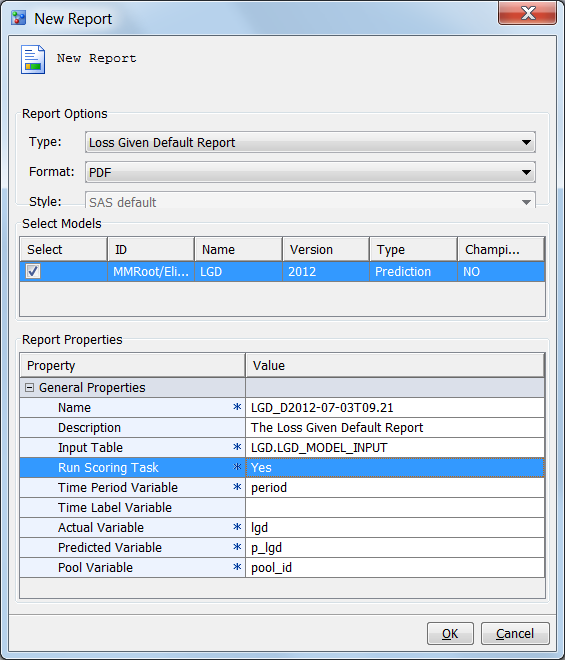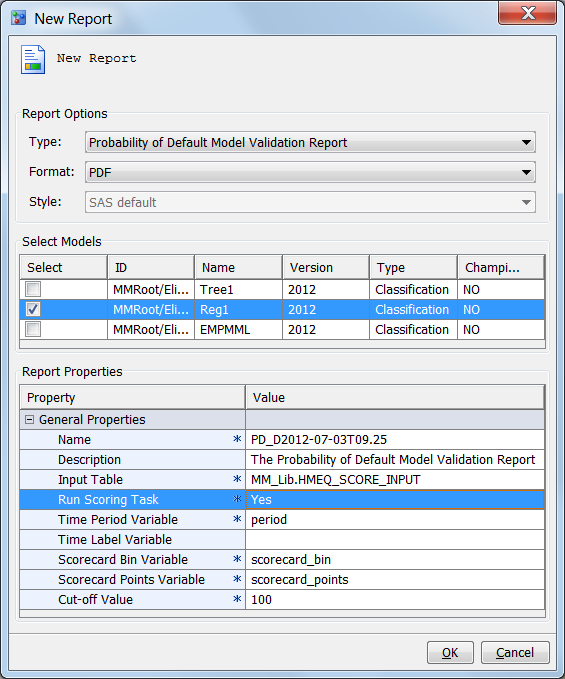Basel II Reports
About Basel II Reports
Basel II reports in
SAS Model Manager provide several statistical measures and tests to
validate the stability, performance, and calibration using Loss Given
Default (LGD) and Probability of Default (PD) models.
For a description of the statistical measures, see Statistical Measures Used in Basel II Reports.
The Loss Given Default and Probability of Default Report Properties
In order to create the
Basel II reports, SAS Model Manager must know the input and output
variables for the model. To run the reports, the New Report window
requires the name of an input table. The input table can contain only
input variables, or it can contain input and output variables. If
the input table contain only input variables only, a scoring task
must be run to obtain the output variable. If the input table contains
the input and output variables, no scoring is necessary. You specify
whether a scoring task must be run by setting the Run
Scoring Task property in the New Report window.
If the input table contains the input and output variables, the value
of the Run Scoring Task can be No.
If the input table contains only input variables, the Run
Scoring Task property must be set to Yes.
The New
Report window report properties requires the name of
the variables from the input and output tables in order to map these
variables to variables that are used by SAS Model Manager uses to
create the reports.
The LGD report properties
map these variables:
| Time Period Variable | specifies the variable that is used to indicate a time period. The first time period begins with 1 and typically increments by 1. The default is period. |
| Time Label Variable | (optional) specifies a label for the time period. If this variable exists in the input table, the report output contains a table that maps time periods to time labels. |
| Actual Variable | specifies the actual LGD variable. The default is lgd. |
| Predicted Variable | specifies the output prediction variable that is used only if scoring for the report is not performed by SAS Model Manager. If the report scoring is done by SAS Model Manager, this variable should be excluded by the input data set. The default is p_lgd. |
| Pool Variable | specifies the variable that names pool IDs. The default is pool_id. |
The PD report properties
map these variables:
| Time Period Variable | specifies the variable that is used to indicate a time period. The first time period begins with 1 and typically increments by 1. The default is period. |
| Time Label Variable | (optional) specifies a label for the time period. If this variable exists in the input table, the report output contains a table that maps time periods to time labels. |
| Scorecard Bin Variable | specifies the scoring output variable that names the scorecard bins. The input table must include this variable if scoring for the PD report is performed outside of SAS Model Manager. If scoring is done by SAS Model Manager, do not include this variable in the input data set. The default is scorecard_bin. |
| Scorecard Points Variable | specifies the scoring output variable that names the scorecard points. The input table must include this variable if scoring for the PD report is performed outside of SAS Model Manager. If scoring is done by SAS Model Manager, do not include this variable in the input data set. The default is scorecard_points. |
| Cut-off Value | specifies the variable that is used to derive whether a credit exposure is a default. The cut-off value is also used to compute accuracy, sensitivity, specificity, precision, and error rate measures. You can use the score difference between accounts that default on loans and those that do not default on loans to determine the cut-off value. The default is 100. |
Create a Loss Given Default Report
-
Complete the Report Properties, the properties with an asterisk are required:
-
Predicted Variable is the project scoring output variable. If the scoring for the LGD report is performed outside SAS Model Manager, the input data set must include this variable. If the scoring for the LGD report is done by SAS Model Manager, the input data set should not include this variable. The default is p_lgd.
Create a Probability of Default Report
-
Complete the Report Properties:
-
Scorecard Bin Variable is the variable from the input table that contains the scorecard bins. If the scoring job for the PD report is run outside SAS Model Manager, the scorecard bin variable must be a variable in the input table. If scoring is done within SAS Model Manager, do not include the variable in the input table. The default is scorecard_bin.
-
Scorecard Points Variable is the variable that contains the scorecard points. If the scoring job for the PD report is run outside SAS Model Manager, the scorecard points variable must be a variable in the input table. If scoring is done within SAS Model Manager, do not include the variable in the input table. The default is scorecard_points.


